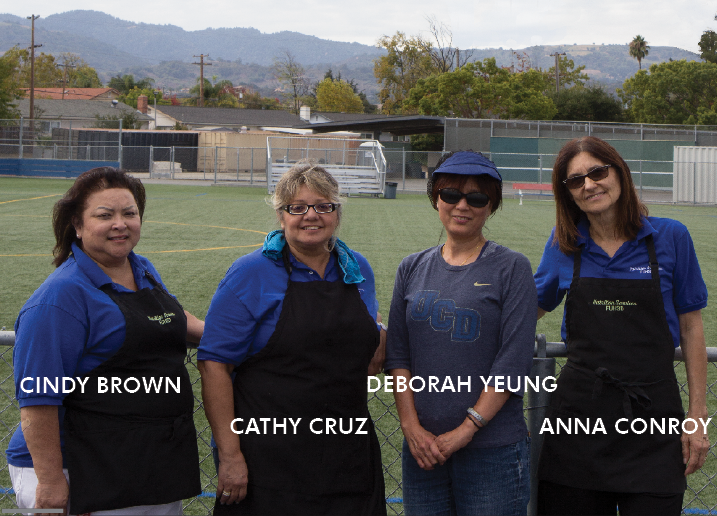Serving the school with warm smiles
October 5, 2018
One year ago, the area was almost completely desolate at lunchtime. Now, a hustle-bustle of starving students sprinting to the small blue-and-white shack next to the football field is a typical sight at 1 p.m.
Since the new bell schedule and school construction took effect this year, the Lynbrook food services staff has flipped its whole operation upside-down. While other schools in the FUHSD turned to food trucks for brunch and lunch during construction, a combination of incredible heat, stuffiness and truck accidents at these schools led to a move to the snack shack near the football field for Lynbrook.
“[The snack shack] was an existing structure, so we didn’t really have to do a whole lot other than move in and tailor it to our needs,” said food services manager Jason Senior. “It unfortunately took away our ability to cook, but it’s only temporary, so we’ll live with it.”
The whole team consists of a diverse, yet in many areas common, set of backgrounds. Jason Senior: manager and mountain biker. Edgar Rodriguez-Vasquez: master chef and rock climber. Then come the ladies, most of whom began working at Lynbrook since their now-grown kids were in school, but have continued because they simply love the job. Anna Conroy: empty nester, avid reader. Cathy Cruz: empty nester, mom of two, loves movies. Cindy Brown: no kids, but loves family and church. Deborah Yeung: reserved mom of three grown kids. Ying Zhao: current and previous Lynbrook mom with her son’s name on the Viking boat that has found its new home next to the tennis courts due to construction.
On a regular weekday before lunch, the women can be found sitting together on a bench near the basketball courts, conversing and laughing while eating lunch. And when the time comes to prepare for lunch, the atmosphere in the snack shack is fun and friendly, jokes and laughs galore. Despite their eclectic range of personalities, they find common interests in their jobs and everyday life at Lynbrook. Together, they adapt to and combat the changing aspects of their jobs and lives.
“I really look forward to coming here in the morning,” Conroy said. “We have some kind of a friendship going on, and we really like to work with each other.”
Just two or three years ago, before Senior and Rodriguez-Vasquez started working at Lynbrook, the women’s jobs were completely different. At the old cafeteria next to the now torn-down quad and under different leadership, the women had to deal with balancing the fast-paced responsibilities of both cooking and serving food in a limited amount of time.
Like before, they quickly switch into action mode at brunch and lunch time, when students come spilling in, all hungry and eager to eat. The snack shack’s design, however, offers minimal interaction between the server and the served.
“I do miss working in the cafeteria,” Brown said. “I don’t get to be personal with the kids [in the snack shack]. Now I’m behind a window, and the only kids I can get personal with are the ones I already know.”
They also have to deal with the snack shack’s smaller and more limited space.
“[The snack shack] gets pretty warm when it’s really hot outside,” Cruz said. “It’s a lot more togetherness [with us working in a smaller area].”
Furthermore, the staff often find themselves separated from the rest of the school due to the new cafeteria location.
“We were participating more in school life before,” Conroy said. “Here, we’re isolated.”
They have noticed a decrease in people, students and teachers alike, coming to buy food at the snack shack, whether it be due to the decentralized location of the snack shack or the later brunch and lunch times.
“For the first week, some teachers came to buy food from us,” Yeung said. “Now, they hardly come anymore.”
Additionally, with the limited space and resources of the snack shack, the hot food sold at lunch must be ready-made and delivered from an outside vendor, while Rodriguez-Vasquez makes all the cold food sold at brunch in the snack shack.
“I would have never seen myself doing this job because I come from restaurants. I liked to cook, I liked to make fancy stuff, I liked to do all that stuff, but it’s stressing,” Rodriguez-Vasquez said. “When I came here and I saw a different side of what it could be, I really enjoyed it.”
Rodriguez-Vasquez and Senior both started working in the corporate world, making and serving food in restaurants and at other events. Nevertheless, they have both found their jobs at Lynbrook much more balanced and enjoyable.
“When you’re at a restaurant constantly stressing, you have no life when you’re working every night. All you do is work. It gets tiring,” Rodriguez-Vasquez said. “Now, I’m not stressed. I get to enjoy my day, and I get to do activities afterward.”
Merely by chance and coincidence, Rodriguez-Vasquez and Senior met. After four years and different jobs together, they continue their collaboration and friendship, bonding over the different food ideas to implement at Lynbrook, shared experiences coming from the corporate food world and even outdoor travels.
“When I first started coming from the corporate world into a school environment, the focus became more on wellness and education as opposed to making money,” Senior said. “It’s a lot more supportive [here], but the challenge for me was to adapt. I hadn’t worked with kids; I’d always worked with adults.”
Throughout the big adjustments of their jobs and work environment, the food services staff have been able to support each other and the students in readily adapting to change. They have been open to student opinions about their food, listening to students’ suggestions and actively coming up with options of new brunch and lunch foods to sell. They may even start sending surveys through Lynbrook administration. Their ultimate mission is to serve the students and ensure that they walk away with big smiles and full bellies.
“We want to make kids happy. We want to see them smile. I say these words everyday,” Zhao said. “Teenagers have a lot of homework, and you have to make them happy in giving them food.”




























































